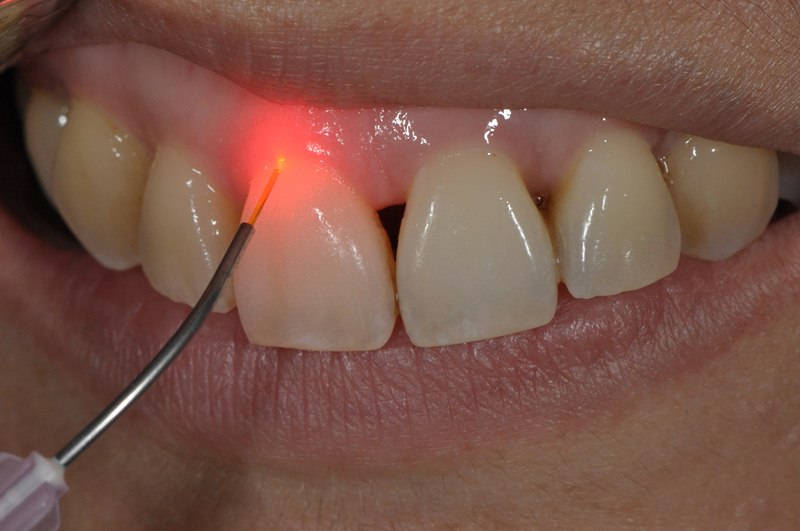
Apart from wavelength and absorption, reflection and transmission also play a role in laser-tissue interaction. Transmission is the degree to which the laser’s energy is able to penetrate into the tissue.
ENDODONTICS
The use of lasers in endodontics is aimed at eradicating germs in the root channel, especially in the lateral dentinal tubulus (necrotic, gangrenous pulp in the corona and root). This requires a wavelength that shows high transmission through hydroxyapatite and water. The absorption curves show that Nd:YAG lasers, and in particular pulsed Nd:YAG lasers, are first-choice for this application. Nd:YAG lasers show the best results in transmission and germ reduction measurements. Even at penetration depths exceeding 1.000μm, 85% germ reduction is accomplished. The 810nm diode laser is the second choice laser source. Micro-biological studies have shown that this source provides the second highest germ reduction, approximately 63%. This is nevertheless significantly.
lower than with Nd:YAG lasers. 980nm diode lasers may also be an option although high transmission is achieved due to its higher absorption in water. This explains why this laser source, especially at a depth of 1.000μm, can only achieve 30% to 40% germ reduction.
All other wavelengths such as Er:YAG, Er,Cr:YSGG and CO2 lasers are not applicable in endodontics. Their absorption in hydroxyapatite and water is so high that germ reduction would predominantly only take place in the main canal, although germ reduction through thermal effects can still be detected in the lateral dentinal tubuli up to depths of 300μm to 400μm. These wavelengths are not very suitable for endodontic treatments. Er:YAG and Er,Cr:YSGG lasers can however be successfully used to remove organic tissue and smearlayers.
LASER-ASSISTED PERIODONTICS
In the periodontics the closed curettage, with a probe depth of 5mm to 6mm, and the open curettage, with probe depths over 6mm, are differentiated.
In cases where periodontal disease is present and it is preferred to perform a closed curettage, lasers can be used for germ reduction after having completed pretreatment and concrement removal using conventional methods. In closed curettage procedures only lasers with wavelengths that do not damage adjacent tissue can be used, while these lasers must also show good interaction with soft tissue and the germ spectrum present in the periodontal pocket. Pulsed Nd:YAG lasers fulfill both requirements; they eradicate germs that have accumulated on the hard tissue surface and, because Nd:YAG lasers interact with pigmented surfaces, reduce germs in periodontal pockets extremely well. 96% of germs in periodontal pockets are pigmented and can thus be selectively eradicated by Nd:YAG lasers. Nd:YAG lasers’ interaction with soft tissue is relatively gentle, i.e. it does not involve any substantial soft tissue damage or removal. They provide a relatively conservative procedure and are associated with rapid wound healing. With Nd:YAG laser procedures, anesthesia is required in less than 50% of cases.
Alternatively 810nm diode lasers show very good interaction with pigmented tissues and thus also induce very high germ reduction, which is similar to that of Nd:YAG lasers. However the interaction with soft tissue is higher and thus the thermal effects and damage to the surrounding tissues is more pronounced. This means that treatments with the 810nm diode laser cannot be performed without anesthesia.
980nm diode lasers can also be considered for laserassisted closed curettage procedures. Their high absorption and interaction with water in the periodontal pockets lead to a high germ reduction. However, their lower interaction with hemoglobin increases the thermal effect in the tissue. If this laser source is not applied with extreme caution in periodontic procedures, surface necroses may be caused. In addition, relatively high tissue temperatures are reached and anesthesia is necessary.
In laser-assisted open curettage procedures Er:YAG lasers are clearly and unambiguously first choice. In special cases a CO2-laser (10.6μm; cw=continuous wave) may be indicated. The Er:YAG laser device of choice for open curettage procedures is a system that, above all, should allow a wide selection of pulse duration and repetition rate settings. These features will allow extremely good inter-radicular and interdental cleaning to be carried out, while bone tissue can be very efficiently freed from infected soft tissue. Moreover, a very fine retentive pattern on the root and bone surfaces can be created, which is of great importance for reattachment.
If the Er:YAG laser device allows the practitioner to vary the pulse duration during the open curettage procedure, then short pulses from 60μs to 120μs are recommended. At these settings thermal effects are extremely low and thus thermal damage is not to be expected. Post-operative bleeding is minimal, so that problem-free wound healing will occur.

